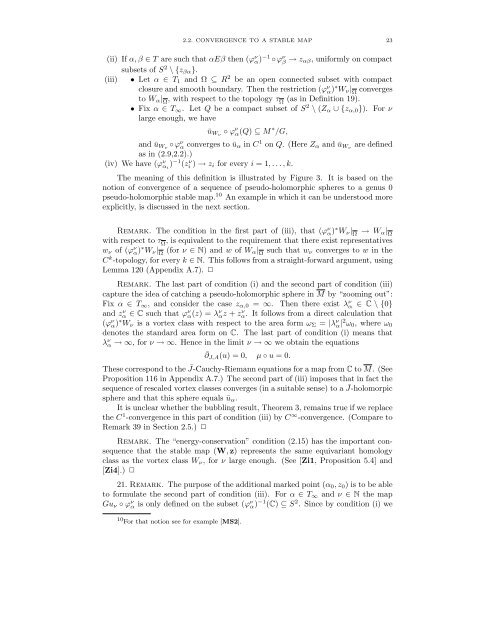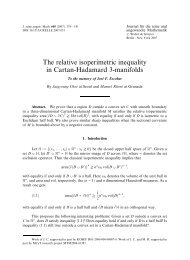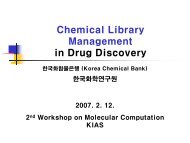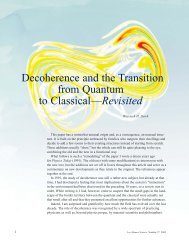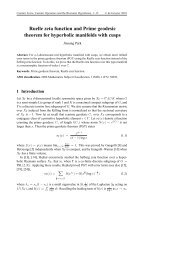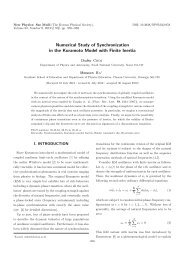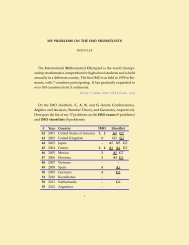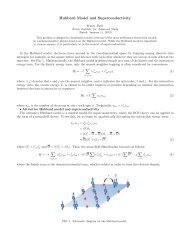A Quantum Kirwan Map: Bubbling and Fredholm Theory for ... - KIAS
A Quantum Kirwan Map: Bubbling and Fredholm Theory for ... - KIAS
A Quantum Kirwan Map: Bubbling and Fredholm Theory for ... - KIAS
You also want an ePaper? Increase the reach of your titles
YUMPU automatically turns print PDFs into web optimized ePapers that Google loves.
2.2. CONVERGENCE TO A STABLE MAP 23(ii) If α,β ∈ T are such that αEβ then (ϕ ν α) −1 ◦ϕ ν β → z αβ, uni<strong>for</strong>mly on compactsubsets of S 2 \ {z βα }.(iii) • Let α ∈ T 1 <strong>and</strong> Ω ⊆ R 2 be an open connected subset with compactclosure <strong>and</strong> smooth boundary. Then the restriction (ϕ ν α) ∗ W ν | Ωconvergesto W α | Ω, with respect to the topology τ Ω(as in Definition 19).• Fix α ∈ T ∞ . Let Q be a compact subset of S 2 \ (Z α ∪ {z α,0 }). For νlarge enough, we haveū Wν ◦ ϕ ν α(Q) ⊆ M ∗ /G,<strong>and</strong> ū Wν ◦ϕ ν α converges to ū α in C 1 on Q. (Here Z α <strong>and</strong> ū Wν are definedas in (2.9,2.2).)(iv) We have (ϕ ν α i) −1 (z ν i ) → z i <strong>for</strong> every i = 1,...,k.The meaning of this definition is illustrated by Figure 3. It is based on thenotion of convergence of a sequence of pseudo-holomorphic spheres to a genus 0pseudo-holomorphic stable map. 10 An example in which it can be understood moreexplicitly, is discussed in the next section.Remark. The condition in the first part of (iii), that (ϕ ν α) ∗ W ν | Ω→ W α | Ωwith respect to τ Ω, is equivalent to the requirement that there exist representativesw ν of (ϕ ν α) ∗ W ν | Ω(<strong>for</strong> ν ∈ N) <strong>and</strong> w of W α | Ωsuch that w ν converges to w in theC k -topology, <strong>for</strong> every k ∈ N. This follows from a straight-<strong>for</strong>ward argument, usingLemma 120 (Appendix A.7). ✷Remark. The last part of condition (i) <strong>and</strong> the second part of condition (iii)capture the idea of catching a pseudo-holomorphic sphere in M by “zooming out”:Fix α ∈ T ∞ , <strong>and</strong> consider the case z α,0 = ∞. Then there exist λ ν α ∈ C \ {0}<strong>and</strong> z ν α ∈ C such that ϕ ν α(z) = λ ν αz + z ν α. It follows from a direct calculation that(ϕ ν α) ∗ W ν is a vortex class with respect to the area <strong>for</strong>m ω Σ = |λ ν α| 2 ω 0 , where ω 0denotes the st<strong>and</strong>ard area <strong>for</strong>m on C. The last part of condition (i) means thatλ ν α → ∞, <strong>for</strong> ν → ∞. Hence in the limit ν → ∞ we obtain the equations¯∂ J,A (u) = 0, µ ◦ u = 0.These correspond to the ¯J-Cauchy-Riemann equations <strong>for</strong> a map from C to M. (SeeProposition 116 in Appendix A.7.) The second part of (iii) imposes that in fact thesequence of rescaled vortex classes converges (in a suitable sense) to a ¯J-holomorpicsphere <strong>and</strong> that this sphere equals ū α .It is unclear whether the bubbling result, Theorem 3, remains true if we replacethe C 1 -convergence in this part of condition (iii) by C ∞ -convergence. (Compare toRemark 39 in Section 2.5.) ✷Remark. The “energy-conservation” condition (2.15) has the important consequencethat the stable map (W,z) represents the same equivariant homologyclass as the vortex class W ν , <strong>for</strong> ν large enough. (See [Zi1, Proposition 5.4] <strong>and</strong>[Zi4].) ✷21. Remark. The purpose of the additional marked point (α 0 ,z 0 ) is to be ableto <strong>for</strong>mulate the second part of condition (iii). For α ∈ T ∞ <strong>and</strong> ν ∈ N the mapGu ν ◦ ϕ ν α is only defined on the subset (ϕ ν α) −1 (C) ⊆ S 2 . Since by condition (i) we10 For that notion see <strong>for</strong> example [MS2].


